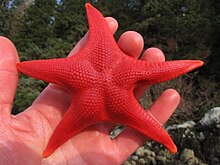Mediaster aequalis
| Vermilion sea star | |
|---|---|

| |
| Scientific classification | |
| Domain: | Eukaryota |
| Kingdom: | Animalia |
| Phylum: | Echinodermata |
| Class: | Asteroidea |
| Order: | Valvatida |
| Family: | Goniasteridae |
| Genus: | Mediaster |
| Species: | M. aequalis |
| Binomial name | |
| Mediaster aequalis | |
| Synonyms[1] | |
| |

Mediaster aequalis is a species of sea star in the family Goniasteridae. It is native to the west coast of North America, ranging from Alaska to California. It is found in various habitats including beaches during very low tides, and at depths down to about 500 m (1,600 ft). Also known as the vermilion sea star, it is the type species of the genus Mediaster and was first described in 1857 by the American zoologist William Stimpson.[2]
Description
M. aequalis has five (occasionally four or six) stumpy arms and grows to a diameter of up to 20 cm (8 in). The aboral (upper) surface is bright red while the oral (under) surface is an orangey-red. The tube feet are red.[3] There is a row of conspicuous marginal plates along the edge of the arms on the aboral surface, and the central disc bears many flat-topped ossicles (platelike calcareous structures); these consist of a central group of granules surrounded by a ring of about twenty-five marginal granules.[4]
Distribution and habitat
M. aequalis is native to the western coast of North America, its range extending from Chignik Bay in Alaska southwards to Baja California. It often inhabits rocky substrates, at depths ranging from the low intertidal to around 500 m (1,600 ft).[4]
Ecology
M. aequalis is both an omnivore and a predator and will scavenge for dead animals and detritus. As well as feeding on algae, it preys on tunicates (such as sea pork), sea pens, sponges, bryozoans, brachiopods and polychaete worms. In its turn it is hunted by the larger morning sun star. It can move at the rate of 40 cm (16 in) per minute, which is fast for a starfish. Juvenile M. aequalis often congregate among the tubes of Phyllochaetopterus prolifica, a tube-dwelling worm,[4][5] and research in Washington state has shown that the larvae are highly selective in where they settle, exclusively choosing to do so on these tubes.[6][7]
References
- ^ a b Mah, Christopher (2008). "Mediaster aequalis Stimpson, 1857". WoRMS. World Register of Marine Species. Retrieved 11 September 2017.
- ^ Stimpson, William (1857). "On the Crustacea and Echinodermata of the Pacific Shores of North America". Boston Journal of Natural History. 6 (4): 530–531. Pl. 23, figs. 7–11.
- ^ "Mediaster aequalis". Race Rocks. Retrieved 11 September 2017.
- ^ a b c Cowles, David (2006). "Mediaster aequalis Stimpson, 1857". Retrieved 11 September 2017.
- ^ "Vermilion star". Sea stars of the Pacific Northwest. 2013. Archived from the original on 2016-09-25. Retrieved 11 September 2017.
- ^ Balch, Toby; Scheibling, Robert E. (2001). "Larval supply, settlement and recruitment in echinoderms". In Jangoux, Michel; Lawrence, John M. (eds.). Echinoderm Studies. Vol. 6. Lisse: A.A. Balkema. p. 10. ISBN 978-90-5809-301-1.
- ^ Birkeland, Charles; Chia, Fu-Shiang; Strathmann, Richard R. (1971). "Development, Substratum Selection, Delay of Metamorphosis and Growth in the Seastar, Mediaster aequalis Stimpson". The Biological Bulletin. 141 (1): 99–108. doi:10.2307/1539994. JSTOR 1539994.
Further reading
- Fisher, Walter Kenrick (1911). "Asteroidea of the North Pacific and adjacent waters pt. 1: Phanerozonia and Spinulosa". Bulletin of the United States National Museum (76): 198–202. doi:10.5479/si.03629236.76.i.
- Lambert, Philip (2000), "Mediaster aequalis Vermilion Star", Sea Stars of British Columbia, Southeast Alaska, and Puget Sound, Royal British Columbia Museum Handbook, Vancouver: UBC Press, pp. 67–68, ISBN 978-0-7748-0825-5
- McEdward, Larry R.; Chia, Fu-Shiang (1991). "Size and energy content of eggs from echinoderms with pelagic lecithotrophic development". Journal of Experimental Marine Biology and Ecology. 147 (1): 95–102. doi:10.1016/0022-0981(91)90039-Y.
- Sloan, N.A.; Robinson, S.M.C. (1983). "Winter feeding by asteroids on a subtidal sandbed in British Columbia". Ophelia. 22 (2): 125–140. doi:10.1080/00785326.1983.10426591.
